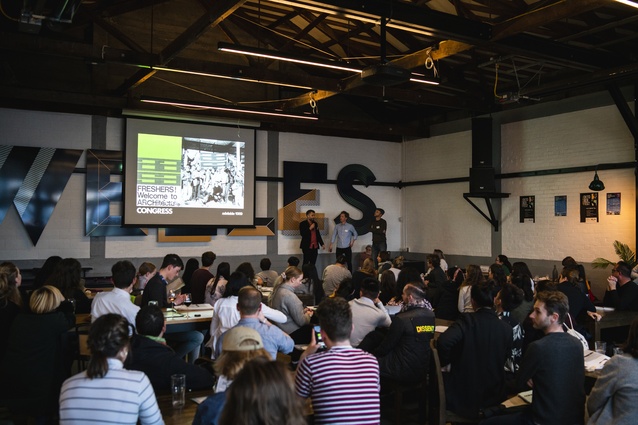Event review: Dissent 2019
For the first time in more than a decade, the Australasian Student Architecture Congress returned to New Zealand, gathering in October in Christchurch with 75 delegates, 21 speakers, 32 scooters, nine separate venues and, surprisingly, zero arrests. It was the 25th iteration of a series of biennial miracles, each event with a different concept from those of the previous ones.
Since its 1961 inception in Sydney as an informal bar crawl (ending with a sleepover in the cells), Congress has increasingly become a robust format of semi-formal gatherings of professionals, academics and thinkers, from inside and outside of the discipline. Each iteration is funded through a series of creative sponsorship partnerships and run by a fresh body of absurdly idealistic students and graduates, working in their own time with their own strategies; however, each is planned in a similar vein.
Dissent 2019 was done on the cheap, the format returning to its roots as a series of small invasions across Christchurch, with discussions, workshops and lectures around decolonisation, feminism in practice, memes (for the adults in the house, ‘visual in-jokes’) and the agency of architects as workers.
Keynote topics included: the work of The Architecture Lobby and advocacy for the rights of practitioners (Peggy Deamer, Keefer Dunn); representation within academia and practice (Adam Nathaniel Furman); plus, new models of working to aspire to (Jack Self). In addition to their presentations, guest speakers were engaged in conversation throughout the week with delegates and with the Australasian leaders, invited to discuss their own ways of addressing key contemporary issues.
Rau Hoskins introduced guests and delegates to the Te Aranga Principles and methods of engaging with mana whenua; Justine Clark and Dr Gill Matthewson shared the work of Parlour; Elisapeta Heta poetically shared her experience as wāhine toa in the discipline and the addition to the architectural landscape; and, alongside Dr Ryan Reynolds (Gap Filler) and Jess Halliday (Te Pūtahi), many local contributors helped site all this in the city of Christchurch. Patrick Reynolds demonstrated the way to ride a Flamingo scooter.
Furman spoke of the Congress spirit: “the energy, resourcefulness and positivity of a student-led event stuck to a razor-sharp focus on the issues it raised and with practical takeaway strategies for students and all attendees to leave with and go into the world as ultra-proactive activists and positive dissenters, agitating for change in an otherwise sclerotic architectural culture.” The sentiment – that architecture can do better – was echoed by delegates.
To dissent is to question the status quo, to challenge what isn’t working and to inquire about new avenues within the discipline of architecture. Dissent 2019 allowed scope and imagination in thinking about how architects might navigate these subjects, drawing together multiple disciplines of architecture.
As Dunn put it: “At a student-run conference, there are no pretensions or academic clout chasing – just a clear focus and reflection on how we, as architects, can work to make the world a better place. With climate change, inequality and other issues looming large, this generation knows that they have no choice but to dissent and fight back.”
The week ended as many others have, at a party: this time, with five enthusiastic pitches for the next Congress, fuelled by caffeine, endorphins and (responsible) drinking. The Australasian Student Architecture Congress will return with the winning hosts, as Occupy in Brisbane, Queensland. In one final act of dissent, this will not be in the anticipated 2021 but will be held next year.
Leaving the last Congress two years ago in Sydney, we felt we’d found a home in future collaborators, promises to come and stay, and arguments to continue later with new friends. At the completion of Dissent 2019, we leave with 74 new friends holding each other to account to speak up about the issues of this industry and to advocate for the best possibilities of what it can be.
– review by Elise Cautley and Alistair Munro
Dissent 2019 could not have succeeded without the generous support of its speakers and sponsors, and its key partners, Te Kāhui Whaihanga New Zealand Institute of Architects and The Warren Trust.
This article first appeared in Architecture New Zealand magazine.











